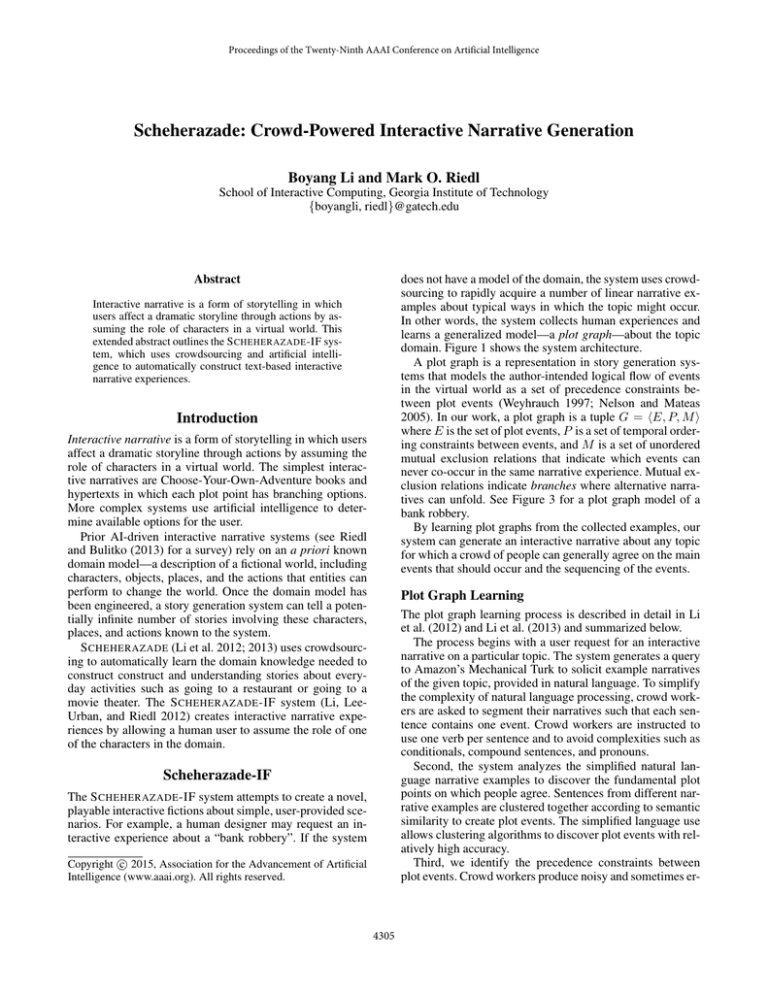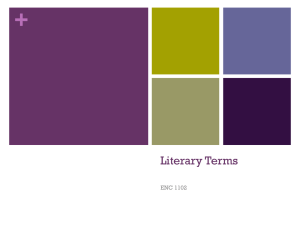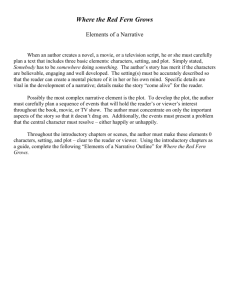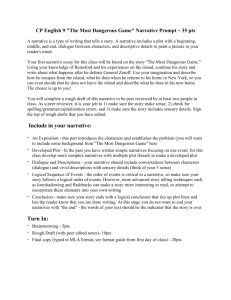
Proceedings of the Twenty-Ninth AAAI Conference on Artificial Intelligence
Scheherazade: Crowd-Powered Interactive Narrative Generation
Boyang Li and Mark O. Riedl
School of Interactive Computing, Georgia Institute of Technology
{boyangli, riedl}@gatech.edu
Abstract
does not have a model of the domain, the system uses crowdsourcing to rapidly acquire a number of linear narrative examples about typical ways in which the topic might occur.
In other words, the system collects human experiences and
learns a generalized model—a plot graph—about the topic
domain. Figure 1 shows the system architecture.
A plot graph is a representation in story generation systems that models the author-intended logical flow of events
in the virtual world as a set of precedence constraints between plot events (Weyhrauch 1997; Nelson and Mateas
2005). In our work, a plot graph is a tuple G = hE, P, M i
where E is the set of plot events, P is a set of temporal ordering constraints between events, and M is a set of unordered
mutual exclusion relations that indicate which events can
never co-occur in the same narrative experience. Mutual exclusion relations indicate branches where alternative narratives can unfold. See Figure 3 for a plot graph model of a
bank robbery.
By learning plot graphs from the collected examples, our
system can generate an interactive narrative about any topic
for which a crowd of people can generally agree on the main
events that should occur and the sequencing of the events.
Interactive narrative is a form of storytelling in which
users affect a dramatic storyline through actions by assuming the role of characters in a virtual world. This
extended abstract outlines the S CHEHERAZADE -IF system, which uses crowdsourcing and artificial intelligence to automatically construct text-based interactive
narrative experiences.
Introduction
Interactive narrative is a form of storytelling in which users
affect a dramatic storyline through actions by assuming the
role of characters in a virtual world. The simplest interactive narratives are Choose-Your-Own-Adventure books and
hypertexts in which each plot point has branching options.
More complex systems use artificial intelligence to determine available options for the user.
Prior AI-driven interactive narrative systems (see Riedl
and Bulitko (2013) for a survey) rely on an a priori known
domain model—a description of a fictional world, including
characters, objects, places, and the actions that entities can
perform to change the world. Once the domain model has
been engineered, a story generation system can tell a potentially infinite number of stories involving these characters,
places, and actions known to the system.
S CHEHERAZADE (Li et al. 2012; 2013) uses crowdsourcing to automatically learn the domain knowledge needed to
construct construct and understanding stories about everyday activities such as going to a restaurant or going to a
movie theater. The S CHEHERAZADE -IF system (Li, LeeUrban, and Riedl 2012) creates interactive narrative experiences by allowing a human user to assume the role of one
of the characters in the domain.
Plot Graph Learning
The plot graph learning process is described in detail in Li
et al. (2012) and Li et al. (2013) and summarized below.
The process begins with a user request for an interactive
narrative on a particular topic. The system generates a query
to Amazon’s Mechanical Turk to solicit example narratives
of the given topic, provided in natural language. To simplify
the complexity of natural language processing, crowd workers are asked to segment their narratives such that each sentence contains one event. Crowd workers are instructed to
use one verb per sentence and to avoid complexities such as
conditionals, compound sentences, and pronouns.
Second, the system analyzes the simplified natural language narrative examples to discover the fundamental plot
points on which people agree. Sentences from different narrative examples are clustered together according to semantic
similarity to create plot events. The simplified language use
allows clustering algorithms to discover plot events with relatively high accuracy.
Third, we identify the precedence constraints between
plot events. Crowd workers produce noisy and sometimes er-
Scheherazade-IF
The S CHEHERAZADE -IF system attempts to create a novel,
playable interactive fictions about simple, user-provided scenarios. For example, a human designer may request an interactive experience about a “bank robbery”. If the system
c 2015, Association for the Advancement of Artificial
Copyright Intelligence (www.aaai.org). All rights reserved.
4305
Human
author
Player
John drives to
bank
Legend
Collect
examples
Agent
Memory
Normal event
Optional event
John enters
bank
Conditional event
Crowd
Precedence relations
John sees
Sally
Mutual exclusion
Execute
narrative
experience
Learn
domain
model
John waits
in line
John covers
face
Sally is
scared
John pulls out
gun
John points gun
at Sally
John scans
bank
John
approaches
Sally
Sally greets
John
Figure 1: The S CHEHERAZADE -IF architecture.
John opens
bank door
John hands Sally
a note
John gives
Sally bag
Sally screams
John shows
gun
John demands
money
The note
demands money
Sally opens cash
drawer
Sally collects
money
Sally gives John
money
Sally reads
note
Sally puts
money in bag
Sally gives
John bag
John collects
money
Sally presses
alarm
John takes
bag
Sally cries
John leaves
bank
Figure 2: A screenshot of game play.
John gets in
car
Police arrives
John drives
away
Police arrests
John
Sally calls
police
Figure 13: A plot graph for the bank robbery situation, created by the smart thresholding method. Tp = 0.75, Tm = 0.05
Figure 3: A plot graph of a bank robbery.
roneous answers such as omitting steps, requiring resilience
against noise. For all pairs of plot events we select between
the two orderings e1 → e2 or e2 → e1 based on statistical frequency (or neither if both orderings are equally likely
or there is not enough data to make a conclusion). Precedence relations with statistically significant frequency and
don’t create cycles are recognized.
Fourth, we identify events that can never co-occur in a
single narrative experience. We measure the mutual information between events to determine whether they belong to
alternative, inconsistent procedures.
non-determinism to the game.96See Figure 2 for an example
of the text-based interface.
References
Li, B.; Lee-Urban, S.; Appling, D. S.; and Riedl, M. O. 2012.
Crowdsourcing narrative intelligence. Advances in Cognitive Systems 2:25–42.
Li, B.; Lee-Urban, S.; Johnston, G.; and Riedl, M. O. 2013.
Story generation with crowdsourced plot graphs. In Proceedings of the 27th AAAI Conference on Artificial Intelligence.
Li, B.; Lee-Urban, S.; and Riedl, M. O. 2012. Toward autonomous crowd-powered creation of interactive narratives.
In Proceedings of the 5th Workshop on Intelligent Narrative
Technologies.
Nelson, M., and Mateas, M. 2005. Search-based drama
management in the interactive fiction Anchorhead. In Proceedings of the 1st Conference on Artificial Intelligence and
Interactive Digital Entertainment.
Riedl, M. O., and Bulitko, V. 2013. Interactive narrative: An
intelligent systems approach. AI Magazine 34(1):67–77.
Weyhrauch, P. 1997. Guiding Interactive Fiction. Ph.D.
Dissertation, Carnegie Mellon University.
Interactive Execution
The plot graph ensures that players always experience valid
stories on the topic, regardless of their choices in the interactive narrative. Once a plot graph has been constructed,
the remaining task is to determine what options—the set of
events that can happen next—are available to the player at
any given time point.
At each step in the game, we compute the set of executable events. A plot event is executable when all of its direct, non-optional predecessors have been executed, except
those parents excluded by mutual exclusion relations.
Executable events may contain options for the player
to select from and also options for non-player characters
(NPCs). Player options are presented to the player as a numbered list of actions to select from. When there are NPC options, S CHEHERAZADE -IF waits a predetermined period of
time for the player to make a selection. If the player hasn’t
acted by the end of the period the system randomly executes an NPC option. This introduces race-condition and
4306







